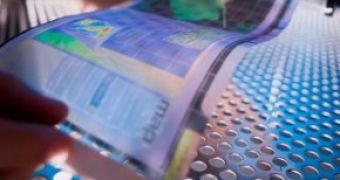Today, Hewlett Packard, the leading manufacturer of consumer computer systems, and the Flexible Display Center (FDC) at the Arizona State University (ASU), demonstrated the prototype of a flexible electronic display that could be used for electronic paper and signage. The affordable solution is capable of rendering a full motion video, while its manufacturing process allows it to provide something that is called “sticky pixels,” which basically enables the pixels of the device to retain their state after the voltage has been removed.
According to the Palo Alto, California-based company, the self-assembly process that patterns the thin film substrate material has been developed without using traditional lithography. Also, it appears that the process is immune to minor distortions caused by variations in manufacturing, which are mainly due to its natural self-aligned nature. This is also the reason why HP has dubbed the process SAIL, short for self-aligned imprint lithography. SAIL features several layers of DuPont's Teijin Films atop of a Polyethylene Naphthalate (PEN) substrate base, also developed by DuPont.
The combination of these materials and HP's SAIL manufacturing process led to the development of a continuous roll of multi-layer active matrix display source material. Although the fully active matrix is capable of handling full-motion video, the material itself also provides properties that are standardly to be found in e-paper applications. The material can retain images in static portions of the display, when the voltage is removed.
“Flexible electronic displays are playing an increasingly important role in the global high-tech industry, serving as the crucial enabling technology for a new generation of portable devices, including e-readers and similar products designed to combine mobility with compelling user interfaces,” said Vinita Jakhanwal, principal analyst at market research company iSuppli, Small and Medium Displays. “We expect the flexible display market to grow from $80 million in 2007 to $2.8 billion by 2013. The Flexible Display Center at Arizona State University is a key participant in helping to develop the technology and manufacturing ecosystem to support this market.”

 14 DAY TRIAL //
14 DAY TRIAL //